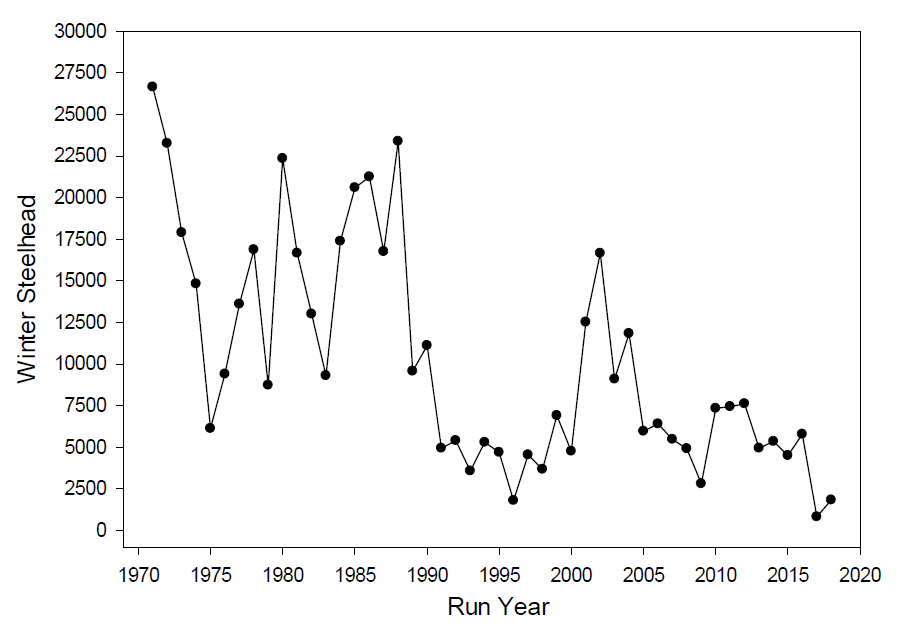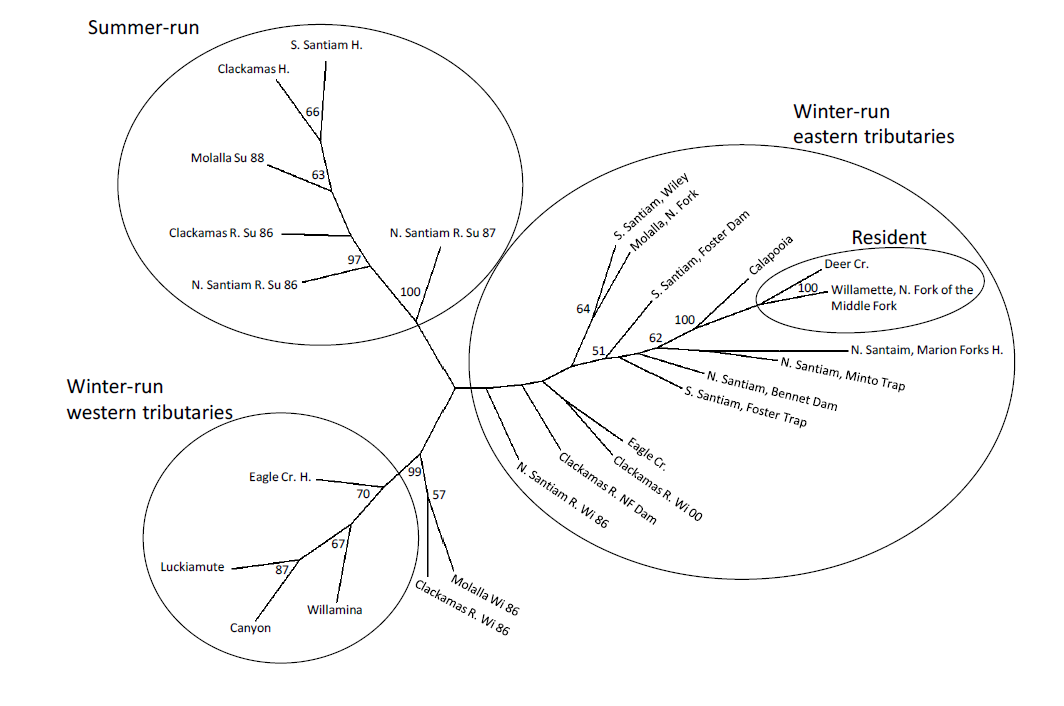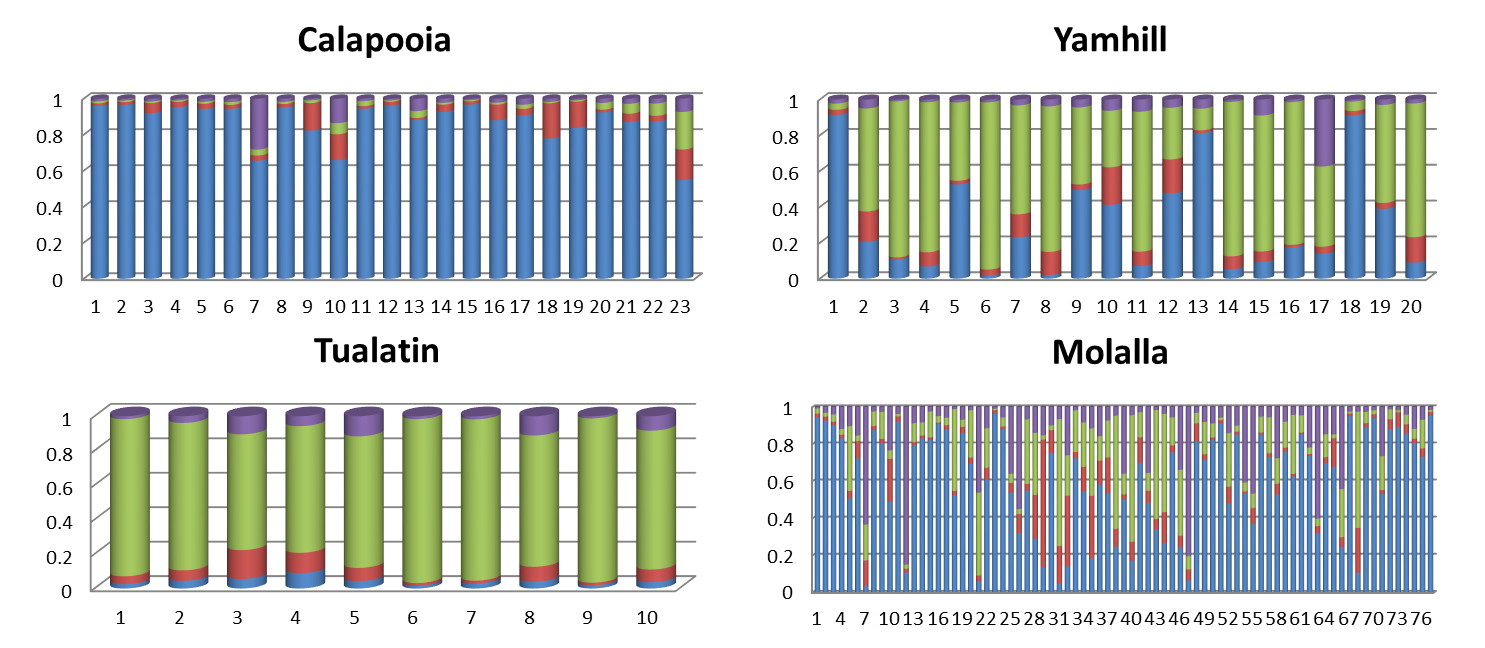Hatchery Programs and Genetic Risk
Winter-run steelhead from the upper Willamette River (UWR) constitute a distinct population segment that has experienced a serious decline in abundance during recent decades (Figure 1). Although protected from harvest by fisheries, native UWR steelhead face threats from predation by pinnipeds and habitat impacts from dams. Hatchery programs in the UWR, which produce and release non-native summer steelhead, also pose risks to native steelhead populations.

Figure 1. Winter steelhead counts at Willamette Falls through the 2017-2018 run year. The count for the 1998-1999 run year (1 November 1998 to 31 May 1999) is incomplete due to the performance of fishway repairs. Data are from ODFW (2018).
Four genetically distinct groups of Oncorhynchus mykiss are known to occur in the UWR basin, recognized as native winter steelhead, native rainbow trout, winter steelhead descended from a lower Columbia River lineage (western tributaries) and hatchery summer steelhead (Figure 2; Van Doornik et al. 2014). Some of these groups are spatially isolated from one another. However, the distributions of native winter and hatchery summer steelhead overlap within the basin, presenting risk of interbreeding and genetic introgression.

Figure 2. Neighbor-joining dendrogram of Cavalli-Sforza Edwards genetic distances among Willamette River steelhead populations. Bootstrap values (%) greater than 50% are shown. The last two digits of the brood year for the earliest samples are included in the sample names. Major groups are circled. From Van Doornik & Teel (2010).
To assess the genetic risk posed by hatchery summer steelhead, we first genotyped unmarked juvenile steelhead sampled at Willamette Falls in 2009, 2010 and 2011 at 15 microsatellite markers. Then, using the Bayesian clustering algorithm implemented in the program STRUCTURE (Pritchard et al. 2000), we estimated the proportions of fish assigning to each of the four genetic groups and hybrids of these. We found that 10.5% of our multi-year sample assigned as summer steelhead and another 9.4% assigned as hybrids of hatchery summer and native winter steelhead (Johnson et al. 2018). These findings confirmed natural production by summer steelhead and hybridization between this stock and native UWR steelhead, as juvenile summer steelhead released from Willamette hatcheries are adipose fin marked, and not included in our sample.
Building upon our initial findings, we set out to identify those areas within the UWR basin that support natural production by summer steelhead. In 2014, we visited and electrofished at 156 sites in the UWR basin, and collected tissue samples from 464 unmarked juvenile fish. We conducted microsatellite-based analyses as before, and found marked spatial structure of summer steelhead and other groups within the basin (Figure 3).

Figure 3. Genetic composition of juvenile O. mykiss samples collected from major UWR tributaries. Each vertical bar represents an individual fish, and the constituent colors represent the genetic lineages represented in that individual, where blue = native winter steelhead; red = native rainbow trout; purple = summer steelhead; and green = lower Columbia winter steelhead lineage. Horizontal blue bars identify samples collected “above” major UWR flood-control dams.
Although our research has uncovered new evidence of a spatially-structured genetic footprint from hatchery summer steelhead in the upper Willamette River, subsequent power analyses revealed limitations of our microsatellite data. Namely, we cannot confidently infer the hybrid class of mixed-ancestry steelhead from our data, such that the current level of introgression from the hatchery steelhead program is unknown (Johnson et al. 2018). However, through collaboration with Oregon’s State Fisheries Genetics Laboratory, we have collected data for 328 single nucleotide polymorphisms (SNPs) from native UWR winter and hatchery summer steelhead. Preliminary analyses of these data offer promise of confident hybrid class assignments that will allow near real-time monitoring of genetic influence and risk from hatchery programs in the UWR basin.
- Johnson et al. 2018. Genetic influence from hatchery stocks on upper Willamette River steelhead Oncorhynchus mykiss
- ODFW. 2018. Upper Willamette Summer Steelhead Hatchery Genetic Management Plan.
- NMFS. 2019. Final Environmental Impact Statement to Analyze Impacts of NOAA’s approval of Hatchery Genetic Management Plans in the Upper Willamette River
- ODFW and NMFS. 2011. Upper Willamette River Conservation and Recovery Plan
- Van Doornik et al. 2015. Genetic population structure of Willamette River steelhead and the influence of introduced stocks.